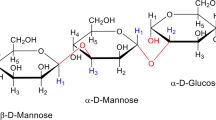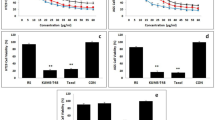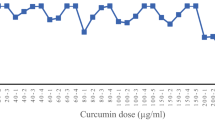Abstract
The exopolysaccharide (EPS) of some Lactobacillus strains has been reported to exert anti-cancer activities. In this study, the effects of crude EPSs produced by four Lactobacillus plantarum strains (Lactobacillus plantarum-12, L. plantarum-14, L. plantarum-32, and L. plantarum-37) on HT-29 cell proliferation and apoptosis were studied. The results showed that the inhibition rate of the crude EPS produced by L. plantarum-12 on HT-29 cell proliferation was significantly higher than that of the EPS produced by the other three strains. L. plantarum-12 crude EPS (50, 100, 250, 500 μg/ml) exerted inhibitory effects on the expression of proliferating cell nuclear antigen (PCNA) in HT-29 cells in a positive dose-dependent manner. The reactive oxygen species (ROS) level and apoptosis rate were also increased in HT-29 cells treated with different concentrations of L. plantarum-12 crude EPS compared with control cells. Further studies found that the expression of the pro-apoptotic proteins Bax, Cyt C, caspase-3, caspase-8 and caspase-9 was upregulated and that the expression of the anti-apoptosis protein Bcl-2 was decreased in HT-29 cells treated with L. plantarum-12 crude EPS compared with control cells. The results suggested that the EPS produced by L. plantarum-12 could inhibit the proliferation of the human colon cancer cell line HT-29 through the mitochondrial pathway.






Similar content being viewed by others
References
Rawla P, Sunkara T, Barsouk A (2019) Epidemiology of colorectal cancer: incidence, mortality, survival, and risk factors. Przegla̜d Gastroenterol 14(2):89–103. https://doi.org/10.5114/pg.2018.81072
Bray F, Ferlay J, Soerjomataram I, Siegel RL, Torre LA, Jemal A (2018) Global cancer statistics 2018: GLOBOCAN estimates of incidence and mortality worldwide for 36 cancers in 185 countries. CA Cancer J Clin 68(6):394–424. https://doi.org/10.3322/caac.21492
Zhu J, Tan Z, Hollis-Hansen K, Zhang Y, Yu C, Li Y (2017) Epidemiological trends in colorectal cancer in China: an ecological study. Dig Dis Sci 62(1):235–243. https://doi.org/10.1007/s10620-016-4362-4
Mármol I, Sánchez-de-Diego C, Pradilla Dieste A, Cerrada E, Rodriguez Yoldi MJ (2017) Colorectal carcinoma: a general overview and future perspectives in colorectal cancer. Int J Mol Sci 18(1):197. https://doi.org/10.3390/ijms18010197
Murphy N, Moreno V, Hughes DJ, Vodicka L, Vodicka P, Aglago EK, Gunter MJ, Jenab M (2019) Lifestyle and dietary environmental factors in colorectal cancer susceptibility. Mol Asp Med 69:2–9. https://doi.org/10.1016/j.mam.2019.06.005
Saus E, Iraola-Guzmán S, Willis JR, Brunet-Vega A, Gabaldón T (2019) Microbiome and colorectal cancer: roles in carcinogenesis and clinical potential. Mol Asp Med 69:93–106. https://doi.org/10.1016/j.mam.2019.05.001
Ambalam P, Raman M, Purama RK, Doble M (2016) Probiotics, prebiotics and colorectal cancer prevention. Best Pract Res Clin Gastroenterol 30(1):119–131. https://doi.org/10.1016/j.bpg.2016.02.009
Nowak A, Paliwoda A, Błasiak J (2019) Anti-proliferative, pro-apoptotic and anti-oxidative activity of Lactobacillus and Bifidobacterium strains: a review of mechanisms and therapeutic perspectives. Crit Rev Food Sci Nutr 59(21):3456–3467. https://doi.org/10.1080/10408398.2018.1494539
Shiomi M, Sasaki K, Murofushi M, Aibara K (1982) Antitumor activity in mice of orally administered polysaccharide from kefir grain. Jpn J Med Sci Biol 35(2):75–80. https://doi.org/10.7883/yoken1952.35.75
Oda M, Hasegawa H, Komatsu S, Kambe M, Tsuchiya F (1983) Anti-tumor polysaccharide from Lactobacillus sp. Agric Biol Chem 47(7):1623–1625. https://doi.org/10.1271/bbb1961.47.1623
Liu CT, Chu FJ, Chou CC, Yu RC (2011) Antiproliferative and anticytotoxic effects of cell fractions and exopolysaccharides from Lactobacillus casei 01. Mutat Res/Genet Toxicol Environ Mutagen 721(2):157–162. https://doi.org/10.1016/j.mrgentox.2011.01.005
Ohta T, Nakatsugi S, Watanabe K, Kawamori T, Ishikawa F, Morotomi M, Sugie S, Toda T, Sugimura T, Wakabayashi K (2000) Inhibitory effects of Bifidobacterium-fermented soy milk on 2-amino-1-methyl-6-phenylimidazo [4, 5-b] pyridine-induced rat mammary carcinogenesis, with a partial contribution of its component isoflavones. Carcinogenesis 21(5):937–941. https://doi.org/10.1093/carcin/21.5.937
Zhang W, Li J, Qiu S, Chen J, Zheng Y (2008) Effects of the exopolysaccharide fraction (EPSF) from a cultivated Cordyceps sinensis on immunocytes of H22 tumor bearing mice. Fitoterapia 79(3):168–173. https://doi.org/10.1016/j.fitote.2007.09.001
Haroun B, Refaat B, El-Menoufy H, Amin H, El-Waseif A (2013) Structure analysis and antitumor activity of the exopolysaccharide from probiotic Lactobacillus plantarum NRRL B-4496 in vitro and in vivo. J Appl Sci Res 9:425–434
Di W, Zhang L, Yi H, Han X, Zhang Y, Xin L (2018) Exopolysaccharides produced by Lactobacillus strains suppress HT-29 cell growth via induction of G0/G1 cell cycle arrest and apoptosis. Oncol Lett 16(3):3577–3586. https://doi.org/10.3892/ol.2018.9129
Wang G, Liu C, Liu J, Liu B, Li P, Qin G, Xu Y, Chen K, Liu H, Chen K (2016) Exopolysaccharide from Trichoderma pseudokoningii induces the apoptosis of MCF-7 cells through an intrinsic mitochondrial pathway. Carbohydr Polym 136:1065–1073. https://doi.org/10.1016/j.carbpol.2015.09.108
Choi S, Kim Y, Han K, You S, Oh S, Kim SH (2006) Effects of Lactobacillus strains on cancer cell proliferation and oxidative stress in vitro. Lett Appl Microbiol 42(5):452–458. https://doi.org/10.1111/j.1472-765X.2006.01913.x
Zhao H, Li J, Zhang J, Wang X, Hao L, Jia L (2017) Purification, in vitro antioxidant and in vivo anti-aging activities of exopolysaccharides by Agrocybe cylindracea. Int J Biol Macromol 102:351–357. https://doi.org/10.1016/j.ijbiomac.2017.04.039
Sun N, Liu H, Liu S, Zhang X, Chen P, Li W, Xu X, Tian W (2018) Purification, preliminary structure and antitumor activity of exopolysaccharide produced by Streptococcus thermophilus CH9. Molecules 23(11):2898. https://doi.org/10.3390/molecules23112898
Tukenmez U, Aktas B, Aslim B, Yavuz S (2019) The relationship between the structural characteristics of lactobacilli-EPS and its ability to induce apoptosis in colon cancer cells in vitro. Sci Rep 9(1):1–14. https://doi.org/10.1038/s41598-019-44753-8
Wang L, Wang Y, Li Q, Tian K, Xu L, Liu G, Guo C (2019) Exopolysaccharide, isolated from a novel strain Bifidobacterium breve lw01 possess an anticancer effect on head and neck cancer-genetic and biochemical evidences. Front Microbiol 10:1044. https://doi.org/10.3389/fmicb.2019.01044
Zhang L, Liu C, Li D, Zhao Y, Zhang X, Zeng X, Yang Z, Li S (2013) Antioxidant activity of an exopolysaccharide isolated from Lactobacillus plantarum C88. Int J Biol Macromol 54:270–275. https://doi.org/10.1016/j.ijbiomac.2012.12.037
Werning ML, Corrales MA, Prieto A, de Palencia PF, Navas J, López P (2008) Heterologous expression of a position 2-substituted (1 → 3)-β-D-glucan in Lactococcus lactis. Appl Environ Microbiol 74(16):5259–5262. https://doi.org/10.1128/AEM.00463-08
Wang K, Li W, Rui X, Chen X, Jiang M, Dong M (2014) Characterization of a novel exopolysaccharide with antitumor activity from Lactobacillus plantarum 70810. Int J Biol Macromol 63:133–139. https://doi.org/10.1016/j.ijbiomac.2013.10.036
Ashwaq A-AS, Al-Qubaisi MS, Rasedee A, Abdul AB, Taufiq-Yap YH, Yeap SK (2016) Inducing G2/M cell cycle arrest and apoptosis through generation reactive oxygen species (ROS)-mediated mitochondria pathway in HT-29 cells by dentatin (DEN) and dentatin incorporated in hydroxypropyl-β-cyclodextrin (DEN-HPβCD). Int J Mol Sci 17(10):1653. https://doi.org/10.3390/ijms17101653
Jiang X, Li T, Liu RH (2016) 2α-Hydroxyursolic acid inhibited cell proliferation and induced apoptosis in MDA-MB-231 human breast cancer cells through the p38/MAPK signal transduction pathway. J Agric Food Chem 64(8):1806–1816. https://doi.org/10.1021/acs.jafc.5b04852
Zorofchian Moghadamtousi S, Rouhollahi E, Karimian H, Fadaeinasab M, Firoozinia M, Ameen Abdulla M, Abdul Kadir H (2015) The chemopotential effect of Annona muricata leaves against azoxymethane-induced colonic aberrant crypt foci in rats and the apoptotic effect of acetogenin annomuricine in HT-29 cells: a bioassay-guided approach. PLoS One 10(4):e0122288. https://doi.org/10.1371/journal.pone.0122288
Kesarwala AH, Krishna MC, Mitchell JB (2016) Oxidative stress in oral diseases. Oral Dis 22(1):9–18. https://doi.org/10.1111/odi.12300
Balaban R, Nemoto S, Finkel T (2005) Mitochondria, oxidants, and aging. Cell 120:483–495. https://doi.org/10.1016/j.cell.2005.02.001
Hu P, Song W, Shan Y, Du M, Huang M, Song C, Zhang L (2015) Lactobacillus paracasei subsp. paracasei M5L induces cell cycle arrest and calreticulin translocation via the generation of reactive oxygen species in HT-29 cell apoptosis. Food Funct 6(7):2257–2265. https://doi.org/10.1039/c5fo00248f
Shi X, Zhao Y, Jiao Y, Shi T, Yang X (2013) ROS-dependent mitochondria molecular mechanisms underlying antitumor activity of Pleurotus abalonus acidic polysaccharides in human breast cancer MCF-7 cells. PLoS One 8(5):e64266. https://doi.org/10.1371/journal.pone.0064266
Arnoult D, Parone P, Martinou J-C, Antonsson B, Estaquier J, Ameisen JC (2002) Mitochondrial release of apoptosis-inducing factor occurs downstream of cytochrome c release in response to several proapoptotic stimuli. J Cell Biol 159(6):923–929. https://doi.org/10.1083/jcb.200207071
Jeon JS, Kwon S, Ban K, Hong YK, Ahn C, Sung JS, Choi I (2019) Regulation of the intracellular ROS level is critical for the antiproliferative effect of quercetin in the hepatocellular carcinoma cell line HepG2. Nutr Cancer 71(5):861–869. https://doi.org/10.1080/01635581.2018.1559929
Carnovale C, Ronco M (2012) Role of nitric oxide in liver regeneration. Ann Hepatol 11(5):636–647. https://doi.org/10.1016/S1665-2681(19)31436-X
Lee TH, Chang J, Kim BM (2014) Saikosaponin C inhibits lipopolysaccharide-induced apoptosis by suppressing caspase-3 activation and subsequent degradation of focal adhesion kinase in human umbilical vein endothelial cells. Biochem Biophys Res Commun 445(3):615–621. https://doi.org/10.1016/j.bbrc.2014.02.046
Ji CF, Ji YB (2014) Laminarin-induced apoptosis in human colon cancer LoVo cells. Oncol Lett 7(5):1728–1732. https://doi.org/10.3892/ol.2014.1952
Rupinder SK, Gurpreet AK, Manjeet S (2007) Cell suicide and caspases. Vasc Pharmacol 46(6):383–393. https://doi.org/10.1016/j.vph.2007.01.006
Kuwana T, Smith JJ, Muzio M, Dixit V, Newmeyer DD, Kornbluth S (1998) Apoptosis induction by caspase-8 is amplified through the mitochondrial release of cytochrome c. J Biol Chem 273(26):16589–16594. https://doi.org/10.1074/jbc.273.26.16589
Zhou WJ, Wang S, Hu Z, Zhou ZY, Song CJ (2015) Angelica sinensis polysaccharides promotes apoptosis in human breast cancer cells via CREB-regulated caspase-3 activation. Biochem Biophys Res Commun 467(3):562–569. https://doi.org/10.1016/j.bbrc.2015.09.145
Ashkenazi A, Dixit VM (1998) Death receptors: signaling and modulation. Science 281(5381):1305–1308. https://doi.org/10.1126/science.281.5381.1305
Zhao S, Li W, Cheng F, Rao T, Yu WM, Ruan Y, Yuan R, Yao XB, Ning JZ (2018) High-pressure carbon dioxide pneumoperitoneum induces oxidative stress and mitochondria-associated apoptotic pathway in rabbit kidneys with severe hydronephrosis. Int J Mol Med 43(1):305–315. https://doi.org/10.3892/ijmm.2018.3986
Allan LA, Clarke PR (2009) Apoptosis and autophagy: regulation of caspase-9 by phosphorylation. FEBS J 276(21):6063–6073. https://doi.org/10.1111/j.1742-4658.2009.07330.x
Felice DL, Sun J, Liu RH (2009) A modified methylene blue assay for accurate cell counting. J Funct Foods 1(1):109–118. https://doi.org/10.1016/j.jff.2008.09.014
Ewaschuk JB, Walker JW, Diaz H, Madsen KL (2006) Bioproduction of conjugated linoleic acid by probiotic bacteria occurs in vitro and in vivo in mice. J Nutr 136(6):1483–1487. https://doi.org/10.1093/jn/136.6.1483
Hernández-García D, Wood CD, Castro-Obregón S, Covarrubias L (2010) Reactive oxygen species: a radical role in development? Free Radic Biol Med 49(2):130–143. https://doi.org/10.1016/j.freeradbiomed.2010.03.020
Zhao X, Wang J, Xiao L, Xu Q, Zhao E, Zheng X, Zheng H, Zhao S, Ding S (2017) Effects of 17-allylamino-17-demethoxygeldanamycin on the induction of apoptosis and cell cycle arrest in HCT-116 cells. Oncol Lett 14(2):2177–2185. https://doi.org/10.3892/ol.2017.6442
Funding
This research project was supported by the National Natural Science Foundation of China (No. 31571813).
Author information
Authors and Affiliations
Corresponding author
Ethics declarations
Conflict of Interest
The authors declare that they have no conflicts of interest.
Ethical Approval
This article does not contain any studies with human or animal subjects.
Additional information
Publisher’s Note
Springer Nature remains neutral with regard to jurisdictional claims in published maps and institutional affiliations.
Rights and permissions
About this article
Cite this article
Sun, M., Liu, W., Song, Y. et al. The Effects of Lactobacillus plantarum-12 Crude Exopolysaccharides on the Cell Proliferation and Apoptosis of Human Colon Cancer (HT-29) Cells. Probiotics & Antimicro. Prot. 13, 413–421 (2021). https://doi.org/10.1007/s12602-020-09699-8
Published:
Issue Date:
DOI: https://doi.org/10.1007/s12602-020-09699-8




